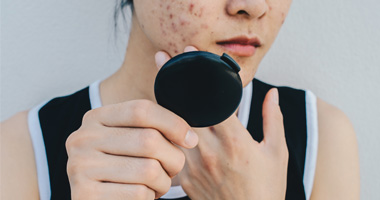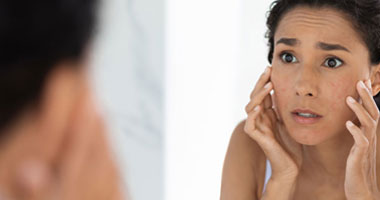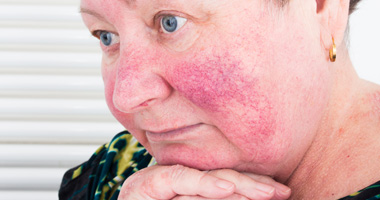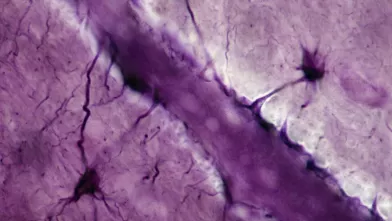The largest human organ, skin is a defensive structure that keeps viruses and bacteria out and moisture in. It also regulates body temperature, produces vitamin D from sunlight, and alerts us to pain, heat, and cold.1
Skin conditions occur when something disrupts, injures, or irritates the skin. Skin conditions are also referred to as dermatologic disorders or cutaneous disorders.1
What are skin conditions?
Skin conditions include various disorders that can result in itching, redness, burning, or swelling.1
Skin conditions may arise when something in the environment inflames, clogs, or irritates the skin, resulting in rashes, hives, or bumps.1 Skin conditions can also be a product of age,2 acquired or inherited genetic mutations,3 stress,4 issues with the immune system attacking healthy cells or tissue,5 and unknown or unclear causes.6,7,8
At any point, as many as one in every three people in the U.S. may have a skin condition.9
How do skin conditions affect the body?
Visible disruptions of the skin can point to a skin condition. This is the case with acne, which is common in adolescents and affects some adults. Some skin conditions, such as changes in skin color, can accompany other health problems, like liver or kidney disease.10
With so many different skin conditions, symptoms may vary. Some common symptoms include:
- Itching, redness, swelling, or burning1
- Rashes or hives, which are bumps whose color can be red or fleshy and may appear and then disappear soon after1,11
- Nodules, whiteheads, blackheads, or pimples12
- Dry or red skin that emerges in patches and may produce clear fluid6
- Dry or itchy skin on the hands, feet, inside the elbows, on the backs of the knees, or on the face7
- Moles that change in texture, shape, size, or color13
- Raised areas of skin that can appear thick or scaly14
- Redness in the face that may also have a burning or tingling sensation15
- Pale patches of skin that typically appear on the face, arms, hands, or feet16
Because skin conditions can alter a person’s appearance, some may also result in negative social and psychological effects.17
- References
- Skin conditions. Medline Plus. https://medlineplus.gov/skinconditions.html. Updated July 16, 2018. Accessed May 15, 2023.
- Acne. National Institute of Arthritis and Musculoskeletal and Skin Diseases. https://www.niams.nih.gov/health-topics/acne. Updated August 2020. Accessed May 15, 2023.
- What causes melanoma skin cancer? American Cancer Society. https://www.cancer.org/cancer/melanoma-skin-cancer/causes-risks-prevention/what-causes.html. Accessed May 15, 2023.
- Psoriasis: Causes. American Academy of Dermatology. https://www.aad.org/public/diseases/psoriasis/what/causes. Accessed May 15, 2023.
- Vitiligo: Causes. American Academy of Dermatology. https://www.aad.org/public/diseases/a-z/vitiligo-causes. Updated June 29, 2022. Accessed May 15, 2023.
- Atopic dermatitis. National Institute of Arthritis and Musculoskeletal and Skin Diseases. https://www.niams.nih.gov/health-topics/atopic-dermatitis. Updated November 2022. Accessed May 15, 2023.
- Eczema. Medline Plus. https://medlineplus.gov/eczema.html. Updated August 15, 2016. Accessed May 15, 2023.
- Rosacea: Who gets and causes. American Academy of Dermatology. https://www.aad.org/public/diseases/rosacea/what-is/causes. Accessed May 15, 2023.
- Skin conditions at a glance. National Center for Complementary and Integrative Health. U.S. Department of Health and Human Services. https://www.nccih.nih.gov/health/skin-conditions-at-a-glance. Updated November 2019. Accessed May 15, 2023.
- What your skin can tell you about your overall health. American Academy of Dermatology. https://www.aad.org/public/diseases/a-z/skin-overall-health. Updated May 27, 2021. Accessed May 15, 2023.
- Hives. Overview. American College of Allergy, Asthma & Immunology. https://acaai.org/allergies/allergic-conditions/skin-allergy/hives/. Updated June 11, 2018. Accessed May 15, 2023.
- Acne: Signs and symptoms. American Academy of Dermatology. https://www.aad.org/public/diseases/acne/really-acne/symptoms. Accessed May 15, 2023.
- Signs and symptoms of melanoma skin cancer. American Cancer Society. https://www.cancer.org/cancer/melanoma-skin-cancer/detection-diagnosis-staging/signs-and-symptoms.html. Updated August 14, 2019. Accessed May 15, 2023.
- Psoriasis: Signs and symptoms. American Academy of Dermatology. https://www.aad.org/public/diseases/psoriasis/what/symptoms. Accessed May 15, 2023.
- Rosacea. National Institute of Arthritis and Musculoskeletal and Skin Diseases. https://www.niams.nih.gov/health-topics/rosacea. Updated May 2021. Accessed May 15, 2023.
- Vitiligo. National Institute of Arthritis and Musculoskeletal and Skin Diseases. https://www.niams.nih.gov/health-topics/vitiligo. Updated October 2022. Accessed May 15, 2023.
- Tuckman A. The potential psychological impact of skin conditions. Dermatol Ther (Heidelb). 2017;7(S1):53-57.

















